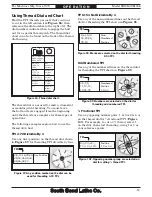
For Machines Mfg. Since 7/09
Model SB1016/SB1036
-43-
O P E R A T I O N
However, other tooling without lock tangs, such
as the remaining four shown in
Figure 66
, can
still be used if the following two conditions exist:
1.
If the potential torque load from smaller
drill chucks, drill bits, and centers will not
override the strength of the MT#5 tapered
fit, the tool can be used.
2.
Usually the end of the arbor or tool that fits
into the quill must be solid and a standard
length.
If the center or tooling has an open hole in the
end of the arbor but is too short to be exposed in
the drift slot for removal, then a screw should be
threaded into the end of the tool. Covering this
hole will provide a solid surface for tailstock pin
to push against when the handwheel is backed
off for tool removal. Also, these short tools do not
seat far enough into the quill to be exposed in the
drift slot. As a result, the edge of the drift key
cannot contact the tool to push it out of the quill.
Should a tool become stuck under these
conditions, remove the quill or handwheel and
drive the arbor or tool out with a long punch.
Figure 67. Inserting drill chuck arbor or tapered drill
bit into tailstock.
Tang
MT#5 Taper
Tang
MT#5 Taper
To remove a tapered drill bit or chuck arbor:
Hold the arbor or drill bit with a rag, and turn
the handwheel counterclockwise until the tooling
is pushed out from the tailstock taper.
— If the arbor or drill bit is stuck in the
bore and cannot be removed by using the
handwheel with moderate force, do not apply
extra leverage to the handwheel. Instead,
extend the quill to expose the drift key slot
in the quill, and use a drift key (see
Figure
62
) to remove the stuck tool.
To install a tapered drill or chuck:
1.
Lock the tailstock in position, then unlock
the quill.
2.
Use the tailstock handwheel to extend the
quill about one inch out of the tailstock.
3.
Insert a tapered drill arbor (
Figure 67
), or
the tapered drill shank, into the quill until
the taper is firmly seated. The matching
tapers hold the arbor.










































